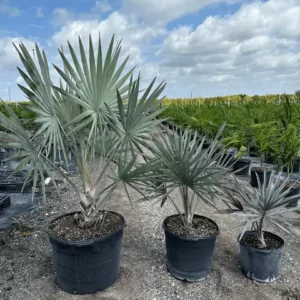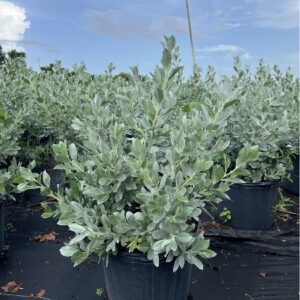
Eugenia Globulus
Eugenia globulus, or Australian Brush Cherry, is an evergreen tree or shrub with glossy dark green leaves and small white flowers, followed by red or purple berries. Thriving in USDA zones 9-11, it prefers full sun to partial shade and well-draining soil. This versatile plant can grow up to 60 feet tall as a tree or be pruned into hedges and topiaries. It requires regular watering and pruning and is ideal for use as hedges, privacy screens, topiaries, or ornamental trees in warmer climates.
$91.41 – $804.04
Related products
-
All Products
Bismarck Palm
$181.09 – $316.91 This product has multiple variants. The options may be chosen on the product page -
All Products
Silver Buttonwood
$22.63 – $586.28 This product has multiple variants. The options may be chosen on the product page
Eugenia globulus, commonly known as Australian Brush Cherry, is an attractive evergreen tree or shrub that is popular for its glossy foliage, ornamental berries, and use as a hedge or topiary.
Color
Foliage: The leaves are glossy, dark green, and lance-shaped. New growth often appears reddish or bronze.
Flowers: Small, white, and fluffy flowers typically appear in spring and early summer.
Berries: Produces small, edible, red or purple berries that are attractive to birds.
Climate
Hardiness Zones: Eugenia globulus thrives in USDA zones 9-11.
It prefers a warm, subtropical to tropical climate and is not frost-tolerant.
Can be grown in cooler climates as a container plant brought indoors during winter.
Size
When grown as a tree, it can reach heights of 30-60 feet (9-18 meters) and a spread of 20-40 feet (6-12 meters).
As a shrub or hedge, it typically maintains a more manageable height of 6-15 feet (1.8-4.5 meters) with regular pruning.
Care
Sunlight: Prefers full sun to partial shade for best growth and berry production.
Soil: Thrives in well-draining, slightly acidic to neutral soil.
Water: Requires regular watering, especially during dry periods. Keep the soil consistently moist but not waterlogged.
Fertilizer: Apply a balanced fertilizer during the growing season (spring and summer) every 4-6 weeks.
Pruning: Prune regularly to maintain shape, especially when grown as a hedge or topiary. Pruning also encourages denser foliage.
Pests/Diseases: Generally resistant to pests and diseases but can occasionally suffer from scale insects, aphids, and root rot if overwatered.
Zone
Eugenia globulus is best suited for USDA hardiness zones 9-11.
Landscaping Uses
Hedges/Privacy Screens: Commonly used for dense hedges and privacy screens due to its thick foliage and fast growth.
Topiary: Ideal for shaping into topiaries and formal garden designs.
Ornamental Tree: Can be grown as an ornamental tree for its attractive foliage and berries.
Container Gardening: Suitable for growing in containers, especially in cooler climates where it can be moved indoors during winter.
Additional Info
Eugenia globulus is relatively low-maintenance but requires regular watering and pruning to thrive.
The berries are edible and can be used in jellies and jams, though they are more commonly left for birds.
It can be propagated from seeds or cuttings, with cuttings being the more common method for maintaining specific plant traits.
The plant’s dense foliage provides excellent habitat and food for wildlife, particularly birds.
| Dimensions | N/A |
|---|---|
| Size | 2 Gallon, 3 Gallon, 7 Gallon, 15 Gallon |
| Shapes | Globe, Spiral, Cone, Pom Pom, 1 Ball, 2 Ball, 3 Ball |


